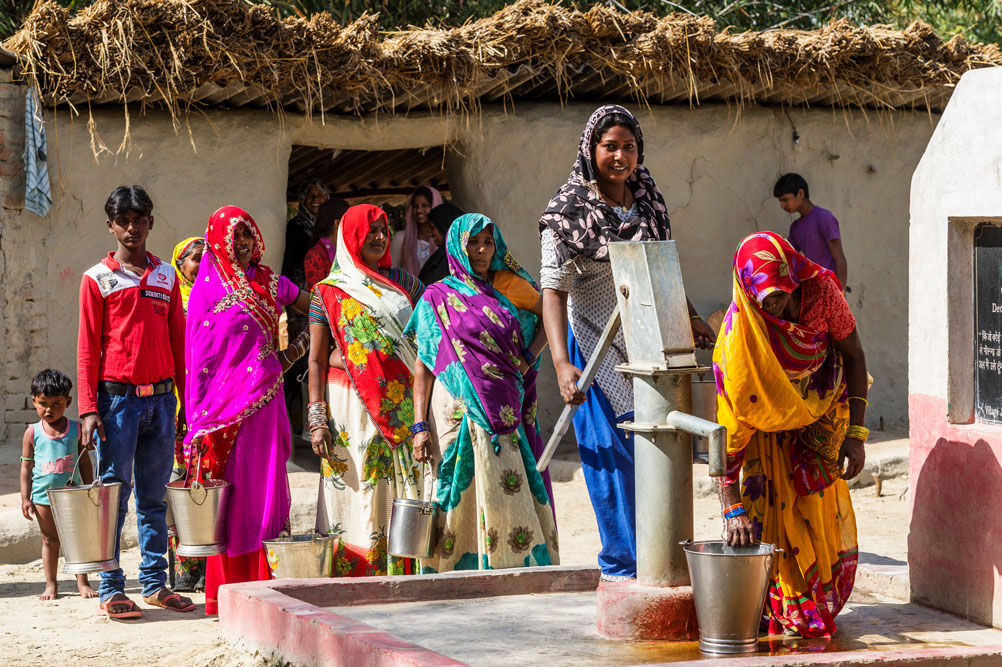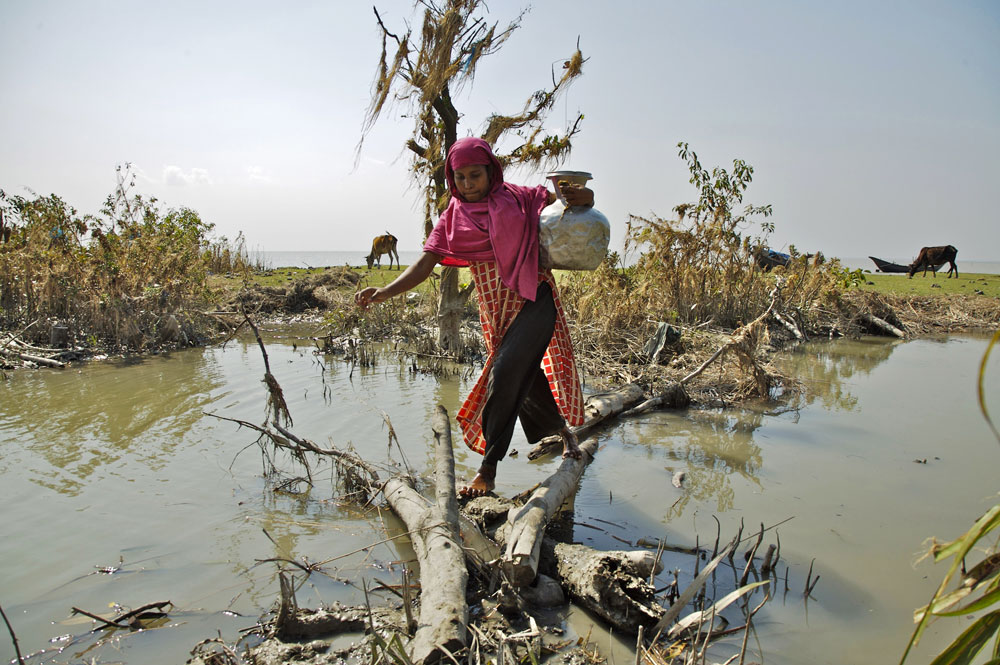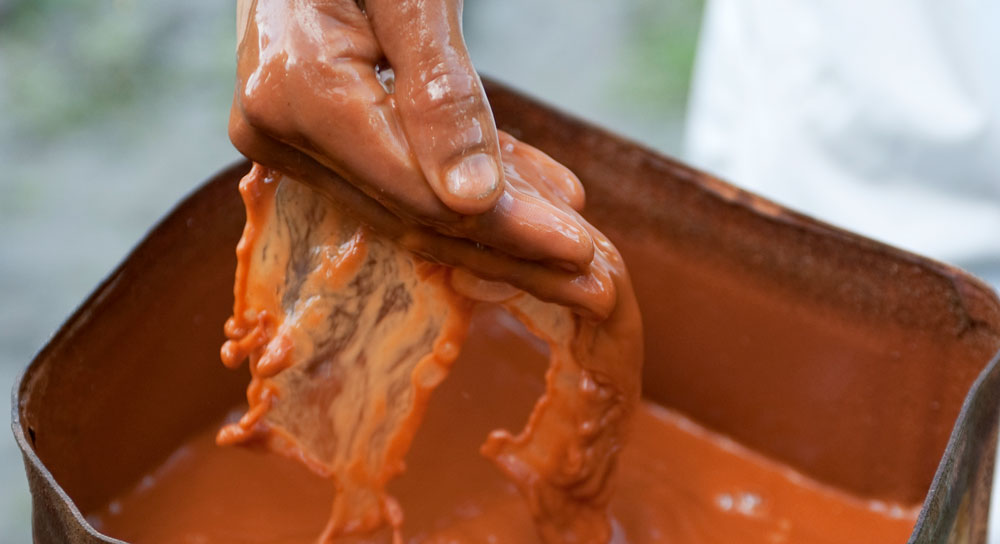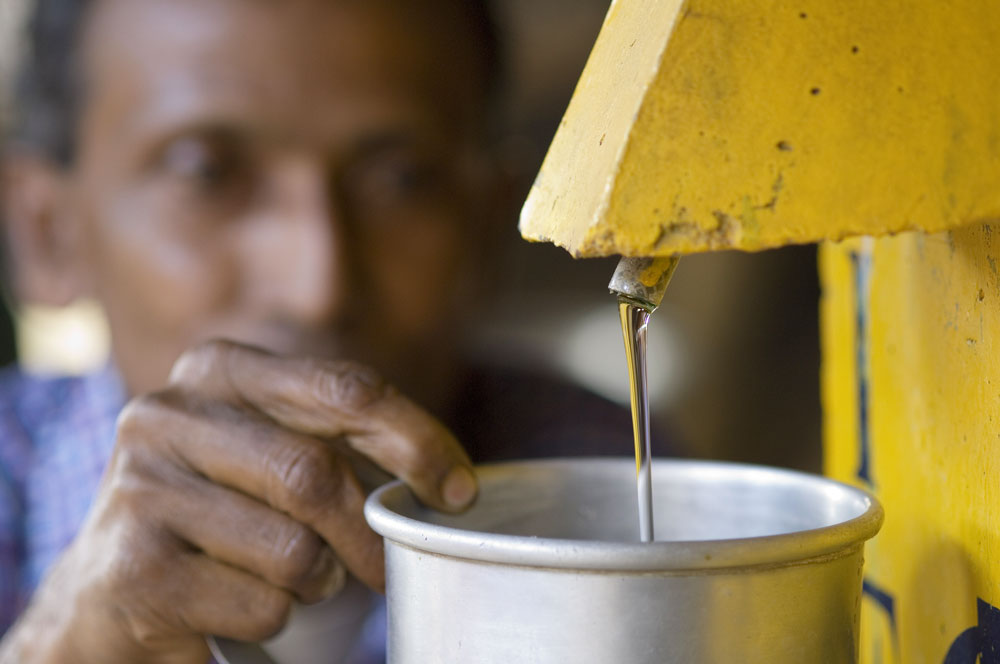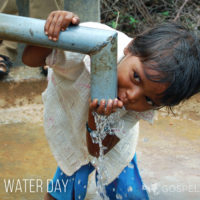WILLS POINT, TX – Gospel for Asia (GFA) Special Report on the global clean water crisis: Discussing the crucial quest for access to clean drinking water. The widespread lack of clean water is a crisis we can’t ignore.

The statistics are mind-numbing.
- 502,000 people die each year from diarrhea—caused by unsafe drinking water.[1]
- 2.1 billion people have no access to safely managed drinking water.[2]
- 159 million people get their drinking water directly from surface water sources.[3]
- 263 million must travel more than 30 minutes daily to collect their water.[4]
Safe drinking water is something most of us take for granted. But for millions of people, the only water they have is contaminated. And millions more are at risk of having no water at all. According to the United Nations, 1.9 billion people (27 percent of the world’s population) live in “potentially severely water-scarce” areas.[5]
For those of us who enjoy ready access to clean water, these numbers are difficult to grasp. But for the individuals they represent, life is simple: They wake up each morning knowing they must fight to survive. The day might begin with a long journey to a watering hole. Everything else depends on that crucial task. For others, the day begins and ends in wretched poverty—because chronic illness prevents them from working. And for some, a normal day means watching their children die slowly from waterborne disease.
This is the heartbreaking reality for people around the globe. The widespread lack of clean water is a crisis we can’t ignore. But to address it, we must understand it.
Why Water Is So Crucial
Water comprises about 60 percent of every human body. It’s essential to the functioning of our cells. And when we don’t take in enough water, things go wrong very fast. We can survive for weeks without food, but without water, we last only a few days.
When acute dehydration sets in, we feel thirsty; then we can begin to experience headaches, dizziness, muscle cramps and rapid heartbeat. If we don’t receive water in time, we may drift into a quiet sleep—and then death. The effects of chronic dehydration can be less dramatic but just as insidious. Over time, the skin may become dry and flaky. Constant fatigue and muscle weakness make it impossible to function normally.
Another cruel fact of life for millions is that the water they do have is contaminated with microbes or deadly trace elements. They can choose to go thirsty—or drink water that makes them sick.
To stay healthy, we need to drink about a half-gallon of water each day. But of course, we need water for more than drinking. We use it to wash our clothes and our bodies. We need it to care for our livestock and to irrigate our crops. So a lack of clean water affects every imaginable area of life. Overall, we need between 13 to 26 gallons to perform all our daily tasks.
Access to safe water is also a key to economic well-being. Farmers need a steady supply of water for their livelihood. If there are no reservoirs to draw from, they must rely on the rain. So when drought hits, the effects can be catastrophic—for the farmers and their entire communities.
People crippled with waterborne disease often spend most of their money and time dealing with it. Work, education and other activities that might help them prosper must be put on hold. Considering all these factors, it’s no wonder that the places with least access to safe water are also among the poorest.
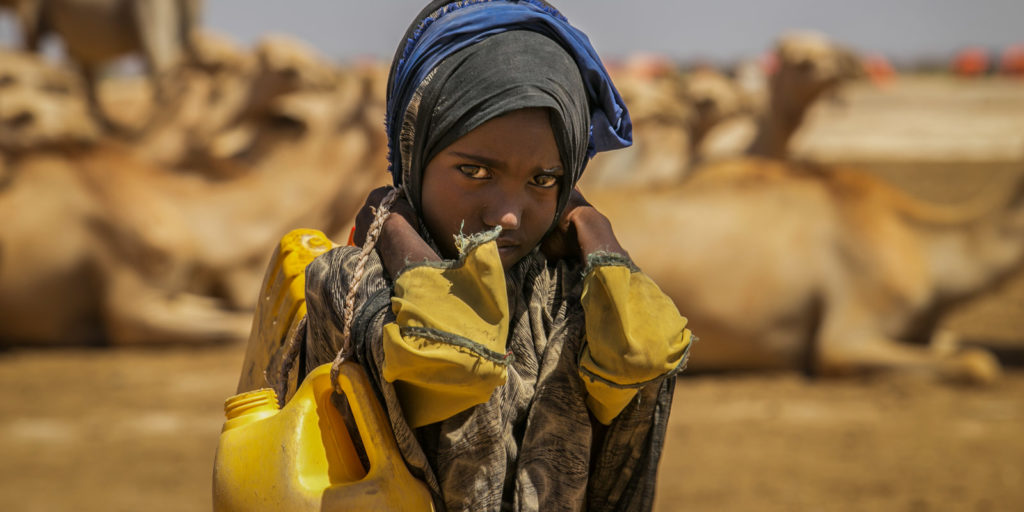
Plentiful—Yet Scarce
There’s enough water on earth to fill 326 million cubic miles (or 1.36 billion cubic kilometers).[6] In fact, 71 percent of the earth’s surface is covered with water.[7] So why is water still so scarce for so many people?
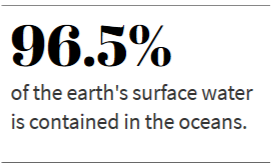 To start with, 96.5 percent of the earth’s surface water is contained in the oceans.
To start with, 96.5 percent of the earth’s surface water is contained in the oceans.
To start with, 96.5 percent of the earth’s surface water is contained in the oceans.[8] And of course, its salt content makes it useless for drinking. Desalination can make saltwater drinkable, but the high cost of that process has put it out of reach for most of the world—so far.
Of the earth’s freshwater, 68.7 percent is locked away in ice caps, glaciers and permanent snow. Another 30.1 percent is in the ground.[9] That leaves only a tiny fraction available as usable surface water, which comprises 78 percent of the water we use. The source of that surface water is the oceans. When water evaporates from the ocean surface, it leaves its salt content behind, and some of it then reaches the earth as precipitation—mainly, rainfall. That water then flows through our rivers and streams and collects in lakes and ponds. We depend on that runoff for most of our water needs.
But geographic and atmospheric conditions can prevent the rain from reaching some places. About 40 percent of the earth’s land mass is considered arid or semi-arid. And together, those areas receive only about 2 percent of the earth’s water runoff.[10] As a result, people who live in those regions often face chronic water shortages and a constant struggle to find adequate water. They typically rely on wells that tap the water in the ground. But when those wells fail, disaster follows quickly.
Digging Deep to Find Water
In some arid and semi-arid regions, people depend on wells that provide water during the rainy season but go dry when the rain stops. There may be more water available deep in the ground, but the wells are too shallow to reach it. Gospel for Asia (GFA) has recognized this problem and has helped solve it by helping to drill wells up to 600 feet deep. The people can then rely on those wells for water all year round.
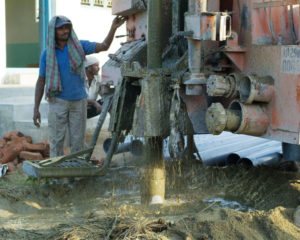
Nirdhar and Karishma’s village sits on a rocky hillside in Asia where, for years, the only water source was the rainwater that collected in a pond. In the dry months, the pond was unreliable, so the villagers would buy water from a visiting tanker truck. GFA-supported pastor Dayal Prasad was aware of the problem and asked his leaders if it might be possible to drill a well for the villagers.
Through the generous donations of GFA supporters around the world, the well project began. But it was risky; the land was notoriously dry. Few local people believed a well was even feasible. The team drilled deeper and deeper into the hard rock terrain with no results. The effort seemed futile. And then, at last—they struck water.
But the team didn’t stop. They drilled even deeper so the villagers would be assured of water through the dry months. And now, they have clean water year-round for drinking, cooking and bathing.
“We never thought a well would be drilled in our village,” Nidhar confides. “But the true need of this village was met by Gospel for Asia. We are truly thankful for it.”
Twin Hazards: Drought and Flooding
Even places accustomed to adequate rainfall can be vulnerable to drought, which may come without warning. Its impact usually depends on the preparations people have made beforehand. Most of the developed world has systems and infrastructure in place to mitigate a drought’s worst effects. In 2018, Washington state and areas of the American Southwest experienced a severe drought, which caused hardship but no large-scale human catastrophe. But it’s a different story when drought strikes poor areas that are already struggling. People die of dehydration. Crops fail and famine follows. Economies are devastated.
Drought is a terrible affliction, but the opposite problem can also occur, and sometimes in the very same places—too much water at once.
Economies are devastated.
Many communities in arid regions are physically unprepared for floods, which often come suddenly. And a lack of groundcover in the desert can make the flooding even more destructive. Floodwaters often mingle with raw sewage, which can cause skin rashes, tetanus, gastrointestinal illnesses and wound infections in people exposed to it. The standing water left behind by floods also breeds mosquitoes, which transmit vector-borne diseases such as dengue, malaria and West Nile fever. In some places, rodents proliferate after flooding. These creatures carry microbes such as leptospira bacteria, which are then released in the rodents’ urine. As a result, leptospirosis can reach epidemic levels after a flood. Left untreated, it can cause respiratory distress, liver failure and death.
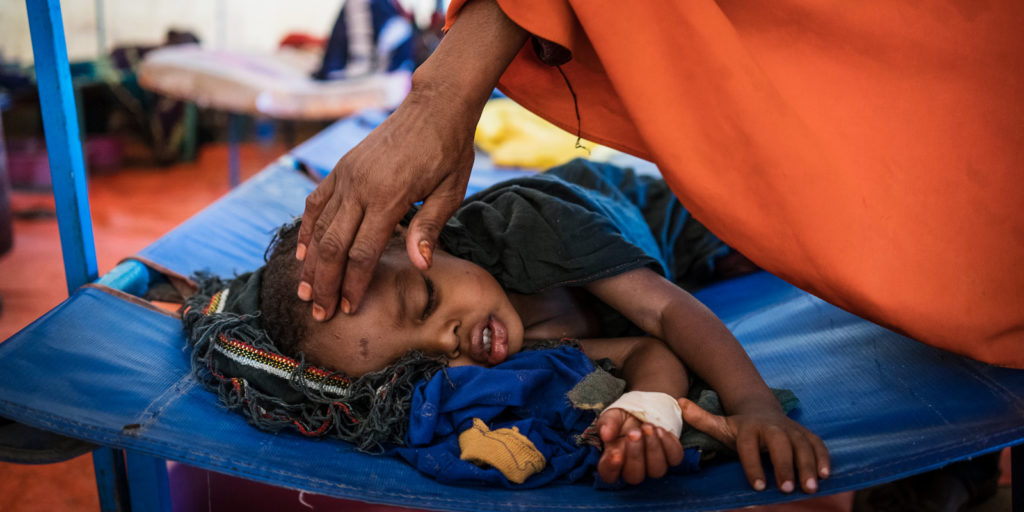
Waterborne Diseases
Even under normal conditions, people in many regions are exposed to life-threatening diseases from their water, including typhoid, polio and hepatitis A. Among the most common waterborne diseases is diarrhea, which can be caused by any of several pathogens. It kills about 1.5 million children every year, more than 80 percent of them in Africa and South Asia. World Health Organization (WHO) estimates that 88 percent of those deaths are caused by unsafe water, inadequate sanitation and poor hygiene.[11] Diarrheal diseases kill by depleting the body’s fluids, often very rapidly.
Children are most vulnerable because their metabolisms use more water than adults’, and their body weight consists of more water proportionally than an adult’s. Their kidneys are also less able to conserve water.[12]
with changes that are simple.
Children with malnutrition and weakened immune systems are especially susceptible to the worst effects of diarrhea. This explains why diarrheal disease is one of the primary killers in poorer countries but not in the developed world. Some diarrheal diseases target adults and older children. One of the most familiar and deadly of these is cholera, which afflicts between 1.4 million and 4 million people each year, killing thousands.[13]
In some documented cases, improving the quality of water at the source, combined with treatment of household water and safe water-storage systems, has reduced the incidence of diarrhea by 47 percent. And studies show that simply handwashing with soap can reduce the incidence by 40 percent.[14] These figures underscore a tragic truth: Diseases that are so deadly can be prevented with changes that are simple.
Trace Element Contamination
Sometimes it isn’t living organisms that make people sick, but it’s the naturally occurring elements in the water. Heavy metals and other trace elements are usually present in our diets, and in fact, many of them are essential—but only in tiny quantities. When we ingest more than the safe levels, we can experience illness and even death.
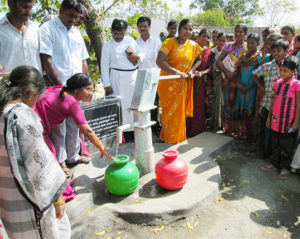
Some of these elements are in the ground and leach naturally into the water we use, while others are introduced into the water supply through industry, mining and agriculture.
This was the problem facing four Asian villages when GFA-supported workers came to the scene in 2014. This area typically experienced several months of drought, followed by heavy monsoon rains. But the water left by the rains was contaminated with chemicals. Villagers with enough money could buy their own water, but the poor had to walk long distances every day to ask for water from local landlords. GFA-supported pastors in the area arranged for wells to be installed in all four villages, bringing clean water at last to approximately 5,300 people.
One of the most well-known water contaminants is lead. Lead poisoning can cause headaches, abdominal pain, mood disorders, high blood pressure, joint and muscle pain, and difficulty with memory or concentration. As always, children experience the worst effects. Lead poisoning can delay their development and cause learning difficulties. They may also experience fatigue, vomiting, hearing loss and seizures.
are not limited to the developing world.
Since lead paint was identified as a major problem in the United States during the 1970s, a concerted national campaign reduced its impact over time. But Americans received a wake-up call in 2014 when the water supply in Flint, Michigan, came under scrutiny—as described by Karen Burton Mains in GFA’s special report “The Global Clean Water Crisis: Finding Solutions to Humanity’s Need for Pure, Safe Water.”[15]
Residents complained about the color, taste and smell of their water. It turned out that the service lines from water mains to individual homes in Flint were made of lead and were not treated with corrosion inhibitors, which keep the contamination at acceptable levels. Eighty-seven cases of Legionnaire’s disease were associated with the contaminated water, leading to 12 deaths. Overall, more than 100,000 people had been exposed to a dangerous poison.
The Flint saga reminded everyone that water is a fragile resource, and its problems are not limited to the developing world.
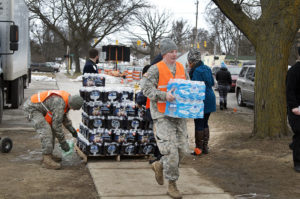
In 2017, the Reuters news agency conducted an investigation that revealed how widespread such issues really are even in the United States. Their reporters discovered 3,810 areas in the U.S with childhood lead poisoning rates twice as high as those found in Flint. And 1,300 areas showed lead levels four times greater than those found in Flint.[16] The affected locations included 34 states and Washington D.C. In the best of outcomes, such a national scandal should at least inspire compassion for others around the world who struggle to find clean water.
Arsenic is well known as a poison, but it’s actually an element that occurs naturally throughout the world. When it enters a water supply, however, it can cause unimaginable suffering.
In 1983, scientists discovered arsenic in the water of 33 villages in West Bengal, India. Subsequent investigations revealed similar contamination in 2,417 villages along the flood plains of the Ganges River.[17]
Arsenic poisoning can cause severe abdominal pain, nausea, vomiting and diarrhea. Other symptoms include abnormal heart rhythm, muscle cramps and tingling extremities. Some victims first notice unusual lesions and growths on their skin, and many then discover they have cancer. Victims of arsenic poisoning can recover if the source of their illness is removed in time.
Several other disease-causing trace elements—most of them heavy metals—contaminate water supplies today. Cadmium accumulates in the kidneys and hepatic system and can cause cancer. Chromium, likewise, can cause liver and skin cancer when it reaches high levels. Zinc and copper can also be dangerous to health.
A Simple Solution
People in the developed world rely on their water providers to protect them from such threats. For those who can afford it, a home filtration system offers added security. But people living in poorer areas have no such protection. They often collect their water from fetid ponds or polluted streams. They’re exposed to all the worst dangers that may be hidden in their water.
Fortunately, a solution exists that can offer them protection similar to what the rest of us enjoy. And it’s amazingly simple, portable, effective and affordable. It’s called a BioSand water filter.
BioSand water filters use mechanical and biological processes to remove heavy metals, bacteria, viruses, protozoa and other impurities from water. They are widely recognized as effective and are small enough to fit easily in virtually any home. Most importantly, they are inexpensive—just $30 for a filter that can serve an entire family with clean water for decades. Seeing the dramatic impact BioSand water filters have, GFA-supported workers have built and provided more than 73,500 of them for Asian families since 2008.
Aanjay, a farmer in Asia, saw firsthand the effects of contaminated water on his family and his entire village.
“We were forced to use dirty and filthy water for cooking and drinking,” he recalls. “Thus, we suffered stomachache, jaundice, typhoid and diarrhea.”
The villagers also had to use the tainted water for bathing, which caused skin infections.
That changed when some GFA-supported pastors provided BioSand water filters for Aanjay’s family and several others.
“Along with receiving a filter, families also received health and hygiene training that works to significantly lower the incidence of waterborne illness,” Aanjay says. “Now the villagers are getting purely filtered water for drinking. Since [the Biosand water filters] were installed, all water-caused and waterborne diseases have ceased.”
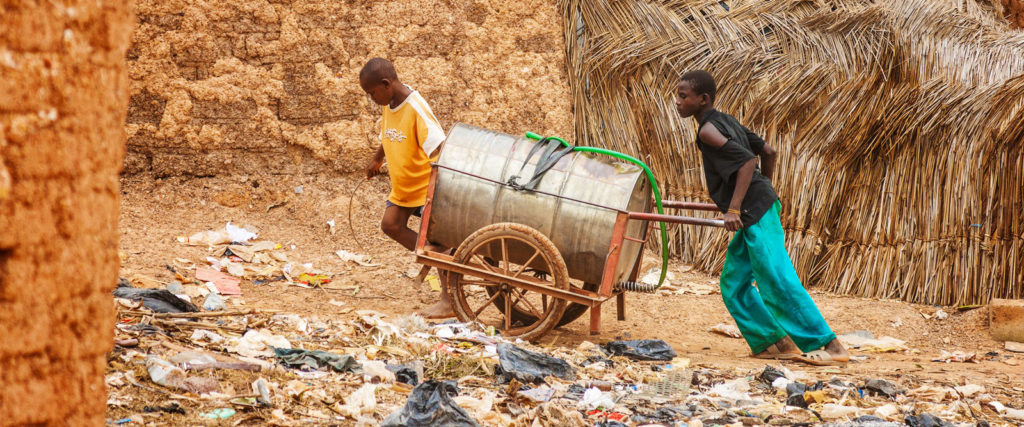
Burkina Faso: Africa’s Anguish
Recurring drought, contamination and lack of funds have all contributed to Africa’s severe water problems. A vivid example of all three can be found in the little landlocked country of Burkina Faso.
Located in the vast savanna region south of the Sahara Desert, Burkina Faso endures up to eight months of dry weather each year.[18] When drought makes conditions even worse, as it did in 2016, a true crisis occurs. That year, the capital, Ougadougou, was able to provide only intermittent water service for its 2 million residents. People were forced to travel far into the countryside to find usable water.[19] Water shortages like this, and the power outages that accompany them, have become a normal part of life for city residents.
For people in rural areas, the hardships are even worse. Eighty percent of Burkina Faso’s people are subsistence farmers,[20] so droughts are especially devastating for them. The country is also plagued by waterborne diseases common to undeveloped areas—diarrhea, hepatitis A and typhoid fever.[21]
According to Water Aid UK, 4,500 children under the age of 5 die of diarrhea each year in Burkina Faso, and nearly half the residents live without clean water.[22] When the rains do come, mosquitoes that breed in the standing water spread malaria, yellow fever and dengue fever.

One of the main industries in Burkina Faso is gold mining. But the mining process has introduced deadly arsenic into the groundwater.[23] On top of all these challenges, the rapidly-growing population is putting unprecedented stress on the water supply. War and disruption in neighboring countries have displaced millions of people, many of whom seek refuge in Burkina Faso. This has only exacerbated a problem that was already severe.[24]
Efforts to improve conditions in Burkina Faso haven’t always been effective. Relief workers from Water Aid UK found that many existing wells there were unusable because of broken handpumps. And toilets provided by the government to improve hygiene were going unused—because people don’t know what to do with them.[25] This underscores the importance of education to go along with physical improvements. One without the other leads to failure.
Against this stark backdrop, a number of entities are working valiantly to reverse the cycle of despair in Burkina Faso. Since 2000, the government has taken real steps to address the crisis, creating five water basin committees to protect and preserve water resources throughout the country.[26] Meanwhile, many non-governmental organizations are helping by drilling new wells, repairing old ones and training local people to manage their water effectively. Among these are the aforementioned Water Aid UK, Myra’s Wells, SIM missionary organization, The Water Project, Hearts for Burkina, Engage Burkina, and Living Water International.
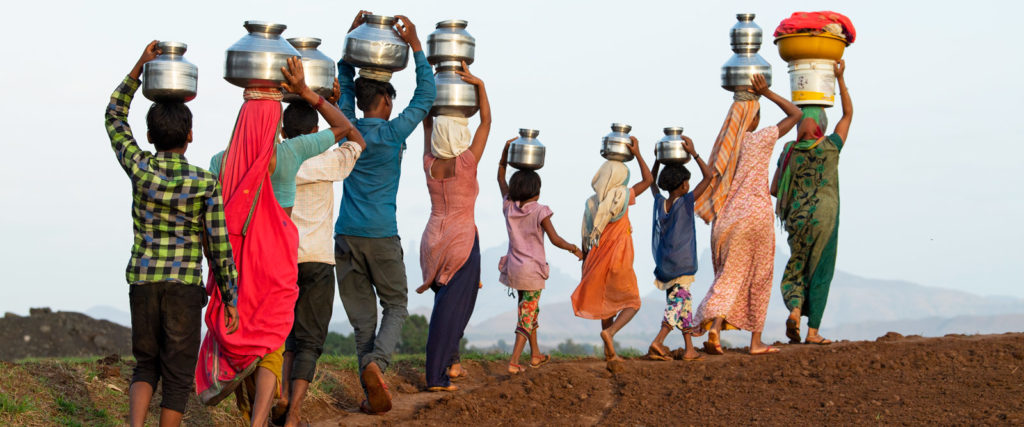
India: Success and Challenge
In recent decades, India has emerged as a global economic powerhouse. It is now the seventh-largest economy in the world by nominal gross domestic product (GDP)[27] and at least the fourth largest in purchasing power parity.[28] Much of this success stems from the technology field, India’s fastest-growing sector. Information technology, process outsourcing and software services are among the country’s booming industries.
But success is accompanied by great challenges. India is home to about 1.34 billion people and is still growing. Its population, now the world’s second largest,[29] is projected to overtake China’s as early as 2024.[30] This has placed unprecedented stress on the country’s water resources, which are already stretched to meet the needs of a growing population.
In June 2018, the Indian think tank NITI Aayog released a comprehensive report on India’s water status. Among its conclusions:
- India is suffering the worst water crisis in its history.[31]
- 200,000 Indians die each year from lack of clean water.[32]
- 600 million Indians face high-to-extreme water stress.[33]
- By 2020, 21 cities could completely run out of groundwater.[34]
- By 2030, the country’s water demand is projected to be twice the supply.[35]
The booming cities have borne a large portion of India’s water stress. Bangalore, known by some as India’s Silicon Valley, is a good example. The city’s needs were once met by wells that reached 300 feet deep. But now, 400 bore wells must go down as far as 1,500 feet to find water. How long will that suffice? No one knows.

In the countryside, the challenges are different but just as dire. Agriculture uses some 80 percent of India’s water.[36] When water is unavailable, the farmers feel it immediately. They can quickly lose their livelihoods.
Meanwhile, millions of Indians have no reliable access to water at all.
Much of India is arid or semi-arid. Vast areas receive rain only sporadically from storms brought by the summer monsoons. Many people collect their water from surface sources, which are often contaminated. The daily trek to a local pond is a regular feature of life for many rural Indians. They may walk for hours just to obtain their day’s supply of water. That leaves little time to work productively or improve their lives.
For years, Gospel for Asia (GFA) has been helping to equip national workers to get wells installed in needy communities. They’re called Jesus Wells and are fitted with a plaque sharing Christ’s words to the Samaritan woman:
“Whoever drinks of this water will thirst again, but whoever drinks of the water that I shall give him will never thirst. But the water that I shall give him will become in him a fountain of water springing up into everlasting life” (John 4:13–14).
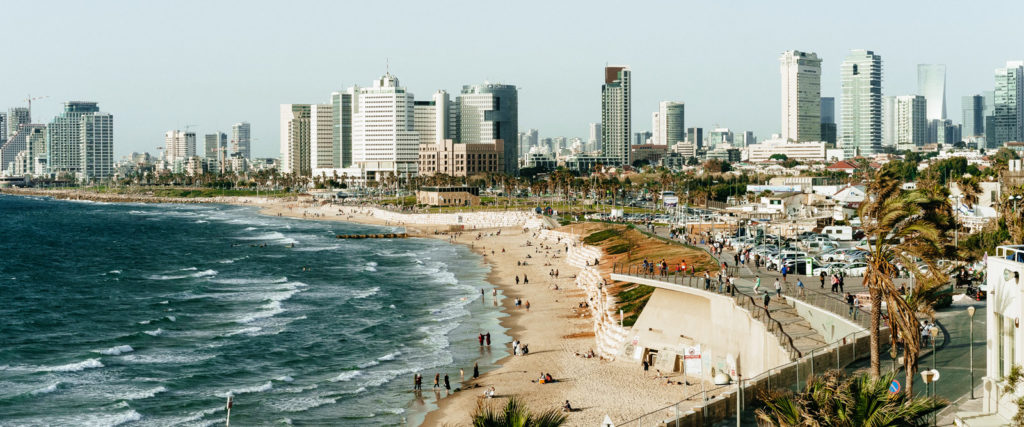
Israel: A Glimpse into the Future
While discussions of global water issues typically focus on the problems, it’s also helpful to consider the success stories. One of those is the tiny state of Israel.
After World War I, the territory of Palestine came under the control of the United Kingdom. As the British government was considering what to do with this important strip of land, its economists concluded that the area’s water resources could only support about 2 million people.[37] There were slightly more than 800,000 residents there at the time. But after the modern state of Israel was created in 1948, that number nearly doubled in just three years—and kept climbing.[38] Today, Israel is home to more than 8 million people,[39] with another 2.8 million in the West Bank[40] and 1.8 million in the Gaza Strip.[41]
Clearly, a drastic program was needed to meet the water demands of this booming population. Through the efforts of visionaries such as water engineer Simcha Blass, Israel not only met this challenge but became an exporter of water technology, water-intensive crops—and water itself. The story of that success can serve as a model and inspiration for other countries.

Photo by Ybact on Wikipedia / CC BY-SA 3.0
Israel’s leaders realized that all those new immigrants would need to eat, so food production became an urgent priority. The Negev in the south of Israel was a vast dry desert where few people lived. But Simcha Blass was convinced there was water underground that could be accessed through deep drilling. He was right. That was the beginning of an agricultural boom in one of the world’s most inhospitable environments. Some people saw it as a fulfillment of the prophecy in the book of Isaiah: “The desert and the parched land will be glad; the wilderness will rejoice and blossom” (Isaiah 35:1 niv).
Blass also envisioned pipelines that would stretch from the water-rich north of Israel to the south where water was most needed. Through years of effort, his visions became reality.
Israel’s visionaries then turned their sights to the world’s most abundant water source—the oceans. The idea of processing seawater for drinking and agriculture has long been an elusive dream for people around the world. Israeli scientists experimented with several desalination techniques, most of which proved too costly to be practical. But with perseverance, Israel developed a system which, though still expensive, provides an important supplement to its other water sources. Israel now has several functioning desalination plants on its Mediterranean coast, which provide an astonishing 27 percent of the country’s water.[42] Most importantly, the desalination plants serve as a kind of insurance policy against severe droughts and other disruptions. The ocean, after all, is always there.
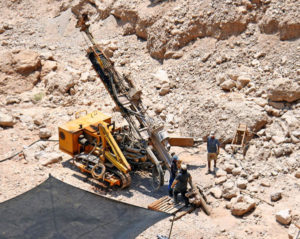
Photo by Tamarah on Wikimedia / CC BY-SA 2.5
Reclaimed waste water is another promising source of water for agriculture that Israel has used effectively. The idea of reusing sewage is repulsive to most people, but when water is at a premium, as in Israel, it’s an option that can’t be ignored. The main concern with recycled waste water is that dangerous microbes or other contaminants might remain even after processing. That could endanger anyone exposed to it, as well as the crops treated with it and the groundwater under the crops. Israel addressed this risk with a process that resembles a giant version of the BioSand water filters described earlier.
Israel’s sewage treatment plants were located near some sand dunes, under which there was a known water aquifer. The water engineers began speculating: What if the treated waste water were released into the sand and allowed to percolate down into the groundwater? Would the sand act as an effective filter? It was a risky experiment, but worth trying. After more than a year, the results were in. Yes, the sand made the water clean, safe enough for agricultural use. Today, Israel reuses more than 85 percent of its sewage, which provides 21 percent of its water.[43]
Israel also pioneered the use of drip irrigation, which made it possible to grow abundant crops by using limited water supplies efficiently.
These innovations may seem out of reach for many developing countries. Their implementation would require concerted, long-term effort, and they can be expensive. But they show what is possible. These are things we know can be done—because they have been done. They point the way to a future free from water insecurity. And that’s something all people can aspire to.
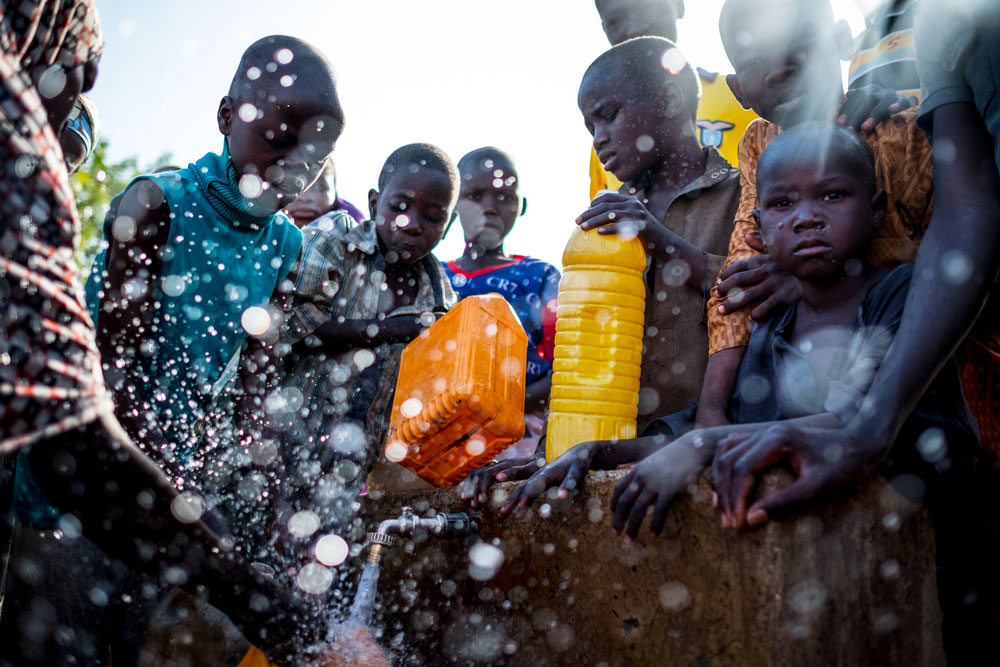
The Big Picture
The world’s need for water has only accelerated with the inexorable growth in population, which could reach another 2 billion by 2050. And by then the demand for water could increase by 30 percent.[44]
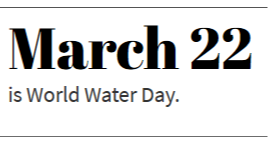
The United Nations has appropriately designated March 22 as World Water Day to focus on the global need for clean water. Along with international bodies like the U.N. and the World Health Organization, countless nonprofits and NGOs are addressing the issue. Many of them focus on Africa, which has some of the most severe water problems. But Asia is in urgent need of help too, and even affluent countries are not immune from water emergencies.
Those who deal with the global water crisis recognize the critical need for funds to attack the problem. Usually, the people most in need don’t address their own problems because they simply can’t. They don’t have the resources. And they often don’t have the leisure time to think beyond their immediate survival. So outside funds are essential to solving the problem. But that’s not all that’s needed.
Relief organizations that drill wells in poor communities must also think about their long-term maintenance. When the local people haven’t been taught how to care for the wells, over time those wells become useless. In a 2009 report, the International Institute for Environment and Development (IIED) noted that 50,000 such wells in rural Africa had become nonfunctional. The reason was distressingly clear: “The root cause is the water community’s failure to plan for maintenance of the infrastructure in a systematic way …”[45]
Outside organizations came in, installed wells with the best of intentions, and then left. But their work did not endure.
Keeping It Local

Gospel for Asia (GFA) knows of the pitfalls that beset many relief efforts. To ensure their work will be sustainable while keeping costs low, GFA-supported workers employ local people to drill Jesus Wells, and they train local people to maintain the wells. In addition, Jesus Wells are constructed with local components, making them much less expensive than those brought in from outside. Buying materials in bulk saves even more money. GFA-supported workers can install a complete well for 1,400 USD. By drilling deep, they can reach water that may have been inaccessible before. Villagers can be assured of water even through the dry seasons.
Jesus Wells are conveniently located for community access, and the water is always freely available to anyone, regardless of religion, class or background. Each Jesus Well serves an average of 300 people, and the wells are built to last for decades.
Along with providing clean water, Jesus Wells strengthen the local economy and inspire a healthy pride of ownership.
In 2017, GFA helped install more than 4,600 Jesus Wells in Asian communities. But that’s just a start. With the generous support of donors throughout the world, GFA-supported workers will continue to help address the global water crisis—one community at a time.
Six Steps to Water Security
The world’s water problems can seem overwhelming. Some of the solutions are complex, difficult and expensive. But others are simple, easy and cheap. Here’s a short list of things that can make a difference—starting with the easiest and ending with the ones that still await as promises for the future.
- Provide BioSand water filters.
Just one of these portable, inexpensive items can literally save an entire family from a life of sickness and hardship. To deprive vulnerable people of this simple solution would be tragic. - Drill deep wells.
Not every well will endure through droughts and overuse, but here’s the key to long-term success: Don’t stop when you hit water! Keep drilling. Deep wells will ensure the water keeps flowing through the dry times. - Train local people to maintain the wells.
What good is a well that’s broken or contaminated? Remember 50,000 wells in Africa alone are sitting unused because of inadequate maintenance. It’s not enough to provide the well. Instilling the knowledge to maintain it over the years is also essential. - Launch water-reclamation programs.
Sewage may be unpleasant, but it’s also a valuable resource. Properly treated, reclaimed water can revolutionize agriculture almost anywhere in the world. - Develop national water policies.
Water is a community resource. It can’t be managed effectively with scattered, isolated efforts. Most national governments are grappling with this reality. Some are responding with effective programs. That must happen on a wider scale. - Pursue desalination.
It’s expensive now. But so are sickness, poverty and death. The ocean is the one water source that will never be depleted. This is a promising avenue for the future.
This Special Report article originally appeared on gfa.org.
Read the Global Clean Water Crisis Report: Finding Solutions to Humanity’s Need for Pure, Safe Water.
Learn more about how to provide clean water to families and villages through Jesus Wells and BioSand Water Filters.
To read more on the Global Clean Water Crisis on Missions Box, go here.

